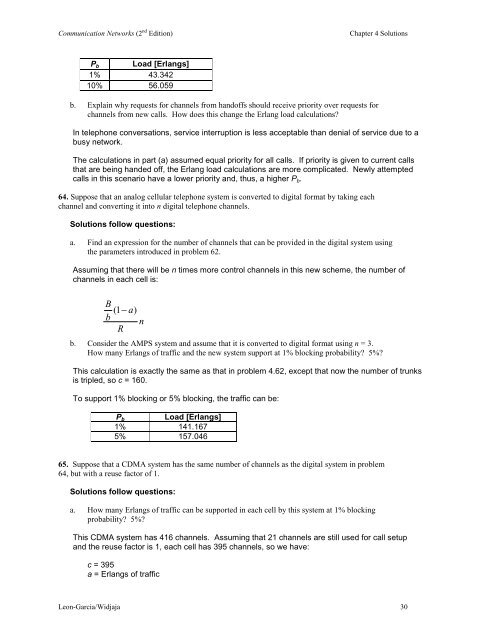Solutions to Chapter 4 - Communication Networks
Solutions to Chapter 4 - Communication Networks
Solutions to Chapter 4 - Communication Networks
You also want an ePaper? Increase the reach of your titles
YUMPU automatically turns print PDFs into web optimized ePapers that Google loves.
<strong>Communication</strong> <strong>Networks</strong> (2 nd Edition)<br />
<strong>Chapter</strong> 4 <strong>Solutions</strong><br />
P b Load [Erlangs]<br />
1% 43.342<br />
10% 56.059<br />
b. Explain why requests for channels from handoffs should receive priority over requests for<br />
channels from new calls. How does this change the Erlang load calculations<br />
In telephone conversations, service interruption is less acceptable than denial of service due <strong>to</strong> a<br />
busy network.<br />
The calculations in part (a) assumed equal priority for all calls. If priority is given <strong>to</strong> current calls<br />
that are being handed off, the Erlang load calculations are more complicated. Newly attempted<br />
calls in this scenario have a lower priority and, thus, a higher P b .<br />
64. Suppose that an analog cellular telephone system is converted <strong>to</strong> digital format by taking each<br />
channel and converting it in<strong>to</strong> n digital telephone channels.<br />
<strong>Solutions</strong> follow questions:<br />
a. Find an expression for the number of channels that can be provided in the digital system using<br />
the parameters introduced in problem 62.<br />
Assuming that there will be n times more control channels in this new scheme, the number of<br />
channels in each cell is:<br />
B<br />
( 1−<br />
a)<br />
b n<br />
R<br />
b. Consider the AMPS system and assume that it is converted <strong>to</strong> digital format using n = 3.<br />
How many Erlangs of traffic and the new system support at 1% blocking probability 5%<br />
This calculation is exactly the same as that in problem 4.62, except that now the number of trunks<br />
is tripled, so c = 160.<br />
To support 1% blocking or 5% blocking, the traffic can be:<br />
P b Load [Erlangs]<br />
1% 141.167<br />
5% 157.046<br />
65. Suppose that a CDMA system has the same number of channels as the digital system in problem<br />
64, but with a reuse fac<strong>to</strong>r of 1.<br />
<strong>Solutions</strong> follow questions:<br />
a. How many Erlangs of traffic can be supported in each cell by this system at 1% blocking<br />
probability 5%<br />
This CDMA system has 416 channels. Assuming that 21 channels are still used for call setup<br />
and the reuse fac<strong>to</strong>r is 1, each cell has 395 channels, so we have:<br />
c = 395<br />
a = Erlangs of traffic<br />
Leon-Garcia/Widjaja 30







